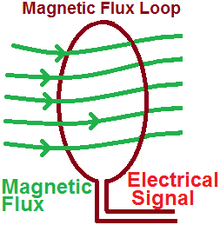Flux loop
A flux loop is a loop of wire placed inside a plasma at a right angle. Changes in the field create a current in the loop, which may be interpreted to measure the properties of the plasma. Flux loops are key diagnostics in fusion power research.
Theory

A flux loop is a loop of wire. The magnetic field passes through the wire loop. As the field varied inside the loop, it generated a voltage, driving a current. This was measured and from the signal the magnetic flux was measured. The voltage induced is determined by:[1]
Typically, you need to integrate the signal over a period of time to get the magnetic field at that instant (not just the change in magnetic fields). This is normally done by adding a integrator circuit which will passively integrate the electrical signal.

Common Uses
The flux loop is common on tokamaks,[2] magnetic mirrors, Field-reversed configurations, the Levitated dipole experiment and the polywell.[1][3] In tokamaks a set of loops is used, and these are spaced slightly off-center and non-concentrically. Placing the loops intentionally asymmetrically allows the users to find the magnetic field density at different points inside the tokamak. The distance between the loops was determined by shafranov, and is sometime called the "shafranov distance".[4]
References
- 1 2 "Principals of Plasma Diagnostics" Second edition, I H Hutchinson, page 11, 2002
- ↑ "NCSX Vacuum Vessel External Flux Loops Design and Installation, PPPL, Twenty-Second Symposium on Fusion Engineering, 2007
- ↑ Park, Jaeyoung; Krall, Nicholas A.; Sieck, Paul E.; Offermann, Dustin T.; Skillicorn, Michael; Sanchez, Andrew; Davis, Kevin; Alderson, Eric; Lapenta, Giovanni (1 June 2014). "High Energy Electron Confinement in a Magnetic Cusp Configuration". arXiv:1406.0133v1 [physics.plasm-ph].
- ↑ shafranov, v,d 1963, plasma physics 5:251

